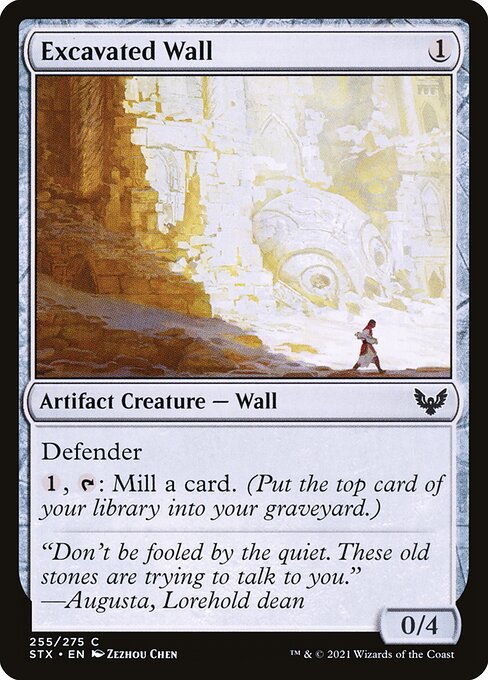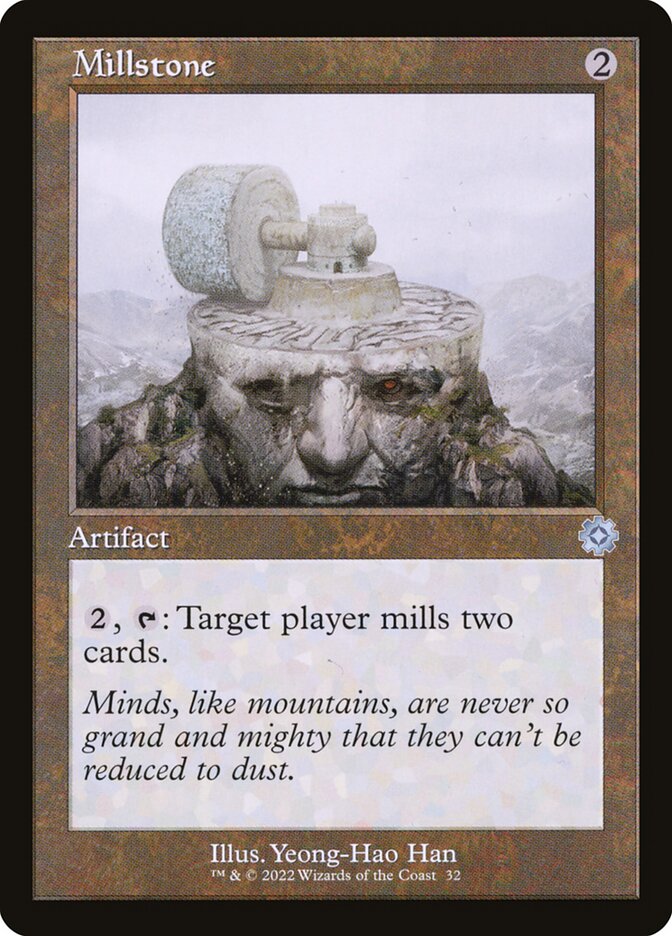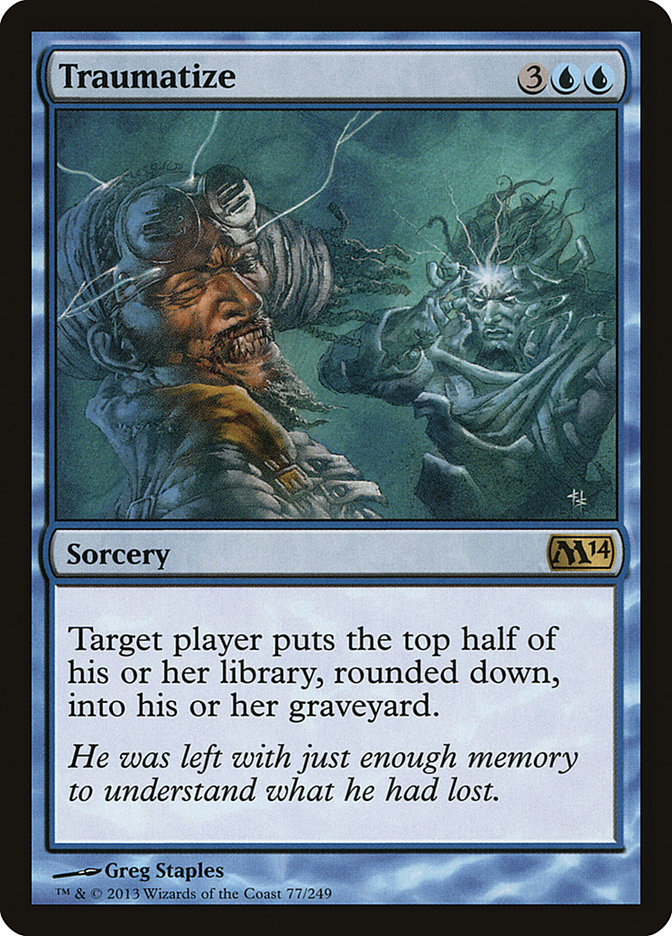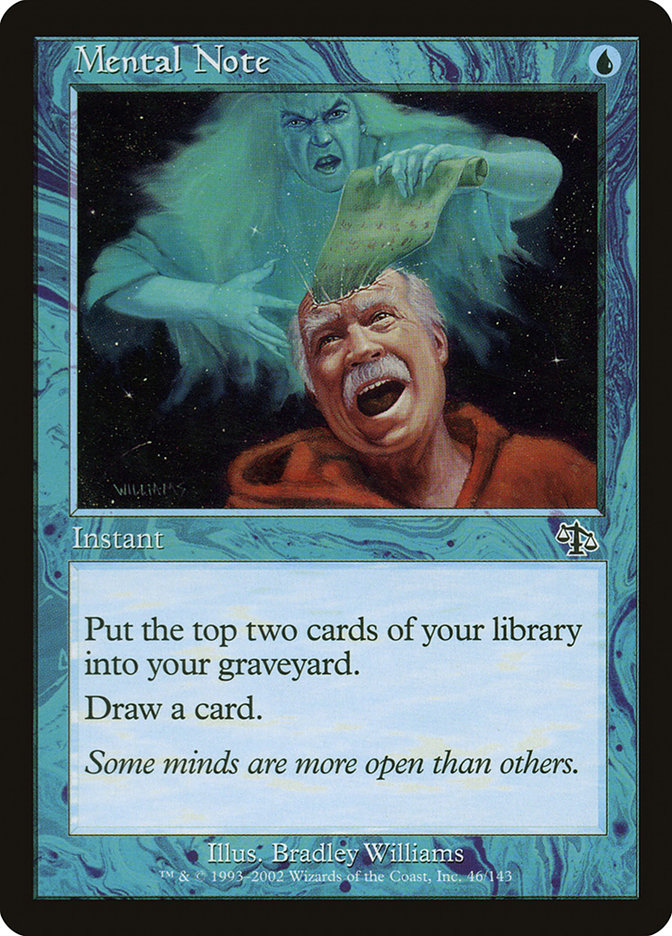posted by on October 13, 2025
Background
Every game of Magic: the Gathering can technically be won by making another player try to draw a card when there are no cards left in their deck, a strategy called “milling.”1 In custom fan formats like Dandân2, there is a single deck shared between the two players, which encourages milling as a more serious backup strategy if the whole “making your opponent lose life” thing doesn’t work out. Recently, I became curious what a custom format might look like if milling was not only a backup but the only strategy? Constraints breed creativity, after all.
Nim is a much older game than MTG about trying not to be the last player to remove an object from a central pile. Every turn, each player can choose to pick up one object, pick up two objects, or pick up half of the remaining objects. It’s often used as an example game with easy rules to implement in introductory computer-science classes, since the game strategy is solved and coding that strategy is simple to do. Part of what makes the strategy so simple is that both players always have the same actions they can take each turn, and the information of what a player can do and how it’ll affect the game is publicly known.
The more I thought about a milling format in MTG, the more it reminded me of Nim: there’s a central pile of objects which each player can affect each turn3 and when the pile runs out, a player loses. If you look deep enough into the history of MTG, you can even find cards that sort of do the same things as each of the actions in Nim:
The cards constraining the actions in MTG tend to be mostly hidden information, and player access to those actions is all dependent on card-drawing. Each player can only hold so many cards in their hand at the end of their turn, and having more cards tends to be better. Ultimately, a game of MTG like Nim boils down to “What happens to the last couple of cards left in the deck?” The rest of the time playing is just about trying to set up for that moment. Nim is turn-based with each player taking only one action. In contrast, MTG has “instants” and “activated abilities” which can be played outside that turn structure, and which follow MTG’s “spells and abilities on the stack” rules for resolution.
From these two ideas, I set out to make a Nim-flavored format of MTG, which I’ve been calling Nimnim4. Because Blue is the most draw-focused and mill-focused color identity, I decided to ignore all other color identities. I searched through hundreds of Blue and/or Colorless cards on scryfall, removing anything that relied on loss of life or other alternate win conditions, and collecting anything that felt similar in spirit to the goals of Nim. Because I was looking for individual cards that looked like they would fit in a format like this, I wound up with a singleton set of a few hundred.
Next, I began to think about what the end of the game would look like. If I wanted the stack to grow to 4-to-5 spells back and forth on the last turn of the game, then the vast majority of cards would have to be very cheap to play. It became difficult to continue to cull cards somewhere around 150 because there were so many that felt like great fits for the format, but eventually I decided that 114 should be the cut-off. The opening hand in magic contains 7 cards, so once the two people comprising a 1v1 match drew their starting hands, that would leave a nice round 100 to work with as the remaining colleciton for Nimnim.
Blue Herrings
When designing a 1v1 Blue mirror format, it was really tempting to throw in a bunch of counterspells, since that’s such a core part of the Blue identity in MTG. However, I found that these tended to be too harsh of a play experience. When a counterspell is played, at least one player tends to wind up not getting to play MTG. I wanted Nimnim to have this momentum of inevitability behind it. No matter what you did, the end of the game would arrive and you had to plan for it rather than just planning to thwart your opponent’s plans and win by default. I wound up removed every spell that outright countered5. Instead, I only kept ones like Remand, Hinder, and Memory Lapse. The latter of these are particularly nice because they allow for continued battling over the top card of the deck, and they can disrupt the math around the total remaining number of cards in the deck.
Another natural Blue identity to lean on is manipulation of handsize. Things like Spellbook and Anvil of Bogardan were considered because they meant more actions per player, which meant more agency, and — hopefully — more fun and faster games. In practice, being able to keep more than 7 cards in your hand at the end of your turn absolutely exploded the possibility space to consider, and with the fact that there were no repeat cards except Islands, this led to extremely long turns and even longer games to weigh the many branching options. Those handsize effect cards were all cut. Obviously, drawing is still a hugely important part of the game, but now you simply have to balance between “getting the card you really want via casting extra draw spells” and “ending the turn with too many good cards in your hand and having to discard to hand-size.”
In certain sets, Blue tends to have lots of artifacts and enchantments with abilities. I wanted to find some that generally provided a big benefit to both players and also ideally a little benefit to one of them, like Lantern of Insight. This proved difficult, though! Well of Knowledge allowed the player with a mana advantage to convert it into a card advantage, in addition to having an ability that could be performed many times in the final turn pretty cheaply. Cards like Horn of Greed and Ghirapur Orrey have symmetrically beneficial abilities, but with how much access to instant-speed bounce effects there are in this cube, the player who usually benefitted the most from the card tended to be the one who didn’t play it.
While I wanted to include some permanents with one-sided abilities, after trying out Teferi’s Ageless Insight and Crucible of Worlds, I realized that there were certain abilities that were simply too strong to be worth keeping in. Teferi’s Ageless insight provided such a huge advantage for one player that the downside of potentially causing your own demise was heavily mitigated by sifting through for the best answers. Lands can be among the most valuable cards early on, with the player who gets ahead on them often being able to access more cards over the length of the game. This mean that more often, Crucible of Worlds wound up being a “win more” card rather than a means to get back into a game. With such little in terms of downsides, these one-sided benefit permanents were too much and I removed them and others like them from the set.
What’s going well, so far?
With the aforementioned goal of inevitable momentum, I’ve found that heavily restraining cards that can recycle from the graveyard in any way has been extremely effective. The only ones currently which pull cards out of the graveyard are Conjurer’s Bauble, Mystic Sanctuary, and Petrified Field, and only two of them return the recycled card to the deck. Because of this, we avoid situations where it feels like the number of remaining cards is ever increasing, and in the bauble’s case, the drawn card makes up for the recycled card, so the endgame still arrives on-time.
Flashback is a wonderful mechanic for milling-centric decks in regular MTG, and it is absolutely at home in Nimnim as well. There are times where a powerful effect from a card has to be weighed against the ability for the opponent to cast the same card for its flashback cost soon after. On the other hand, flashback cards can create interesting emergent gameplay when the randomly milled cards from the deck include some of these flashback cards, which then generates new options.
Delve is another mechanic that balances flashback out well and makes use of the fact that there are going to be dozens of cards in the graveyard in every game of Nimnim at some point. Cards like Treasure Cruise and Dig Through Time were strong in their own right when they came out, but with the shared graveyard, and especially with cards with Flashback or Retrace or Escape being so valuable in Nimnim, these delve cards become some of the strongest in the whole format because of how much graveyard disruption they can manage.
Many of the cards are deceptively simple. Mental Note, for example, is a card I used to play in Nimnim whenever I saw it because it was cheap and was a cantrip.6
However, with the cost being so low, it being at instant speed, and it disrupting 3 cards in the deck all make it a useful card in the late game. If your opponent began their turn with 3 cards left in the deck, you could play this just before their draw step and they would have to do something at instant speed to avoid losing the game. Meanwhile, you’ve only expended one mana, so there’s still plenty of room to follow it up even if they do have an answer.
Finally, I’ve really enjoyed scry, surveil, and cards like Index, which all let you affect what’s coming up next in the deck. There’s this back-and-forth meta-game about how to order the cards that I find captivating. If left in order, each player will draw each card during their turn. This means the person sorting through the cards should give themselves the best cards and their opponent the worst ones. However, since neither players knows what cards are in the other’s hand, it can be difficult to play around what instant-speed effects the opponent may have, even if you have a few of your own. I’ve seen cases during playtesting where both players know the top card is powerful and then several spells get played to try to fight over trying to draw it first. This sort of metagame of locking your opponent into bad cards encourages interesting play in the early-to-mid-game, from my experience, and it makes the skill ceiling and replayability of the format increase as well.
What’s next?
I’ve played Nimnim a handful of times with my buddy, 2Blave, to playtest it, and I have yet to outright win.7 Playtesting has all been done on TableTopSimulator thus far, since the “only one deck”, “shared graveyard”, and “no keeping track of lifetotals” all deviate pretty significantly from the more commonly supported online MTG formats. There continues to be a set of mechanics that are a little bit awkward in TTS, like searching the deck for anything or putting the card on the bottom during a Scry ability, but we’re able to make do for now. As we continue to refine, I’ll probably eventually get to a point where I set up a mod in the workshop for playing it, though I can’t promise I’ll do any scripting.
As of writing this, Nimnim has 80+ unique cards that aren’t basic Islands, and that complexity alone means it continues to be a game for absolute sickos with a bunch of time on their hands. It has been difficult to find people to test it with, even among various groups of MTG fans I’m connected to online. I’m hopeful that future iterations will be a lower time commitment. Ideally, something like 60-90 minutes per game would be nice.
These last few points have another solution: remove MTG altogether, create new and simplified cards that fit exactly what I’m looking for with this format, remove mana in favor of some easier to explain action economy, and then ideally start playtesting with folks who aren’t familiar with MTG at all. It’d be a ton of work, but it’d be just as easy to playtest in TTS, and if it did wind up being fun, I could see there being two different style versions of the game based on difficulty, just like how Spiel des Jahres has different tiers for family-style games and connossieur-style games.
In the meantime, feel free to reach out if you have questions or anything, and hopefully I’ll have more progress soon.
Footnotes
-
Because of https://scryfall.com/card/atq/56/millstone ↩
-
Named after the card Dandân, originally named after the mythical Arabian fish ↩
-
With a minimum of one card that must be drawn by default during their “draw step” each turn. ↩
-
From Nim + Dandân, though it could also have been called “Nimnîm” ↩
-
Meaning any spell that, once resolved, puts the countered spell into the graveyard with no upside for that spell’s owner. ↩
-
A card which when played draws a new card, thereby replenishing the possible actions the player could take, as though they had spent nothing. ↩
-
Most recently, I won but as we looked closer at the end of the game, it became clear that he had me beat a couple of times over and it was more a fault of the way the deck number was being reported in-game than anything good I did. I’m counting it as a draw. ↩




